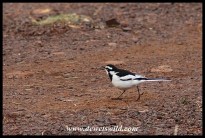Motacilla aguimp
African Pied Wagtails are always found near bodies of water, both natural and man-made and both flowing and stagnant, but with a particular fondness for wide rivers with sandy banks and boulders in and around the water. Here they feed mainly on invertebrates ranging from worms to crabs, but will also consume tadpoles, small fish and seeds. Adults weigh around 27g and grow to about 20cm in length.
Pied Wagtails are usually seen in monogamous pairs, or small family groups during the breeding season. Both parents work to build the cup-shape nest, often over or otherwise near water, using grass, leaves, hair and feathers. Their breeding season stretches from late winter to early autumn. The clutch of 2-5 eggs are incubated by both parents for around 2 weeks, with the chicks becoming independent at around 6 weeks of age.
The African Pied Wagtail has a very wide distribution over sub-saharan Africa and along the Nile River, and is classified as being of least concern by the IUCN. In South Africa they are mainly found from the Eastern Cape through Kwazulu-Natal to Mpumalanga, Limpopo and Gauteng, extending into the North West, Free State and Northern Cape along the Orange-Vaal Riversystem.






















Onse klomp is neefies en niggies van julle klomp!
Ek wonder… sal hulle ooit bymekaar uitkom?
Die Boerseun en die Irish Beauty?! Pret!! 😉
LikeLiked by 1 person
Interessant dat hulle so baie na mekaar lyk!
LikeLike
They are cute little things in their formal black-and-whites 🙂
LikeLiked by 1 person
Very much so, and when you see a few together it looks like such a black-tie affair!
LikeLiked by 1 person
They are such pretty little birds – they make me smile!
LikeLiked by 1 person
I think we all have a soft spot for the wagtails!
LikeLike
It’s a very cute little bird!😊 It is very similar to the wagtail, white wagtail, we have here in Sweden on body shape.
LikeLiked by 1 person
Indeed, John – the wagtails are very easily discernible!
LikeLiked by 1 person
Very pretty!
LikeLike
They really are most endearing!
LikeLiked by 1 person
A very pretty bird.
LikeLiked by 1 person
We can only nod in agreement, Maralee!
LikeLike
Kwikkies is dierbare voëltjies en die bont enetjie is nog pragtig daarby ook. Mooiste foto’s, dankie Dries!
LikeLiked by 1 person
Baie dankie, Dina. Ja, ek het ook n sagte plekkie vir die kwikkies – wens ek kan bietjie van die skaarser soorte wat af-en-toe hier in Suid-Afrika opduik ook sien.
LikeLiked by 1 person
Ek dink ons het al daaroor gepraat, maar kon jy al meer uitvind oor die parasiete wat die gewone kwikkies se pootjies aanval? Ek merk dit al meer op. Soms het hulle net een been of net stompies waarop hulle rondhop.
LikeLiked by 1 person
Ja, Dina, dis n hartseer storie en weer een waar die mens n “vinger in die pie” het. Volgens n studie deur UJ is dit n gevolg van die hoogs aansteeklike Knemidocoptes myt wat die beenweefsel aanval, die bloedtoevoer afsny en so vrot die beentjie of voetjie dan uiteindelik af. Ons wilde voels het dit by troetelvoels aangesteek.
LikeLiked by 1 person
Dis nou interessant. Is daar ander wilde voëls ook wat aangetas word?
LikeLiked by 1 person
Die studie was baie spesifiek tot kwikstertjies, maar self het ek ook al janfrederikkies, geelvinke en duiwe gesien wat aangetas is. Ek het nog nooit gevalle in reservate gesien nie, altyd net in die stad (Germiston en Pretoria) en hopelik word die besmetting beperk tot stede en dorpe waar mense en hul hokvoels hou.
As jy tyd het en kans sien vir n stuk wetenskaplike leeswerk, kan jy gerus hier loer Dina: https://ujcontent.uj.ac.za/vital/access/services/Download/uj:12203/CONTENT1
LikeLiked by 1 person
In Swakopmund is die kwikkies erg aangetas. Ek het al van hulle gesien met geen voete nie en soms net een stompie waarop hulle rondhop en dan bietjie rus. Ongelooflik hoe hulle aanpas. Dankie ek gaan beslis lees as ek kans kry.
LikeLiked by 1 person
Die aanpasbaarheid van lewende wesens!
LikeLiked by 1 person
Wagtails seem so endearing!
LikeLiked by 1 person
I agree!
LikeLiked by 1 person
Why can’t I “like” or comment on your posts the last few months? I seem to be blocked?
LikeLike
Oops! Looks like I’m in again. 😉
LikeLiked by 1 person
It must’ve been the spamfilter, Beth, mistreating you so horribly – but I am glad that it appears to have been sorted!
LikeLiked by 1 person
So am I. Now all that needs to happen is to figure out how my own blog works and start posting again. Occasionally, I can log into one, but not the other. ;-(
LikeLike
Such beautiful and charming birds. We have wagtails as neighbours near our home too. I can watch them all day 🙂
Best wishes,
Takami
LikeLiked by 1 person
They’ve been a favourite since childhood for me as well, thanks Takami!
LikeLiked by 1 person
Another beautiful bird! I love it!
LikeLiked by 1 person
Thanks, Deb!
LikeLike
It really is sweet. A bit like a cross between our Willie Wagtails and our Magpie Larks. 🙂
LikeLiked by 1 person
Glad they have a familiar look about them for you!
LikeLiked by 1 person
I felt like you posted it for me. You can never have enough of the Wagtails. 🙂
LikeLiked by 1 person
This bird really stands out with its black and white coloring!
LikeLiked by 1 person
They really do, thanks Hien!
LikeLike